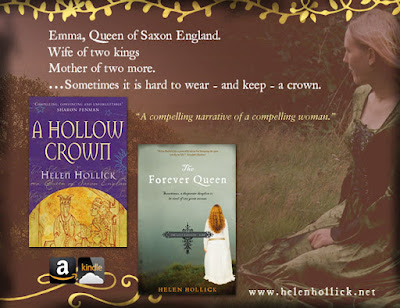Many of history’s powerful women have long been relegated to the shadows of history, one is Emma of Normandy the remarkable but little-known Anglo-Saxon Queen Emma.
 |
| Frontispiece from the Encomium Emmae |
ALLIANCE
The marriage of alliance between Emma of Normandy and Æthelred, King of the English in 1002 was, sixty-four years later, to be the indirect cause of the Norman Conquest of 1066. Emma was little more than a pawn, a sister to the ruling Duke, Richard II. An alliance of marriage would, in theory, prevent Danish Vikings from using Norman ports, where they regularly over-wintered and from where they harassed England. The idea failed, but Normandy now had a foot in the door to obtain the wealth of their English neighbour. Considering that this alliance between Normandy and England was supposed to bring security from Viking raiders, it is ironic that when Æthelred died in 1016, Emma almost immediately married one of the most prominent Vikings of this period: Cnut the Great of Denmark.
Emma was not Æthelred’s first wife, but she was the only one to be anointed as Queen. Her first son, Edward, was born circa 1005, with a second son, Alfred, coming a year or so later. The succession to the throne however, was disrupted in 1013 with the invasion of Svein Forkbeard of Denmark and his son, Cnut.
In the autumn, Emma and her sons, at her initiative, fled to Normandy, soon followed by Æthelred himself. He was a weak king, he failed to keep the Danish at bay, letting them walk in by the back door to take England for their own. Fortunate for Æthelred, and Emma, Swein died and Cnut was too young to pick up the reins.
But young sons grow older and he came back. Æthelred died, leaving his wife and her two sons in a difficult situation.
KEEPING THE CROWN
Emma had a choice: flee or make a bargain. She again sent her sons into exile in Normandy and made that choice – to offer her hand in marriage in order to bring stability and credibility to Cnut as King. That was the official version, it was more likely because she wanted to keep her crown and power. As it turned out, it seems to have been a happy, successful marriage, although there were a few hiccups – Cnut’s first wife demanded her share of the spotlight for herself and their sons. Emma was having none of it. Emma ensured that the first wife was booted out of England (she was sent to oversee Cnut’s conquest of Norway as regent – she made a mess of it) and Emma settled in as Queen Consort and Regent of England when Cnut was absent on his many trips abroad.
.jpg) |
Contemporary portrait of King Cnut from the New Minster Liber Vitae, 1031 |
EXILE
Cnut, however, died when he was in his early thirties. Their son, Harthacnut, was occupied with seeing to the security of Denmark so First Wife, Ælfgifu of Northampton, took the opportunity for revenge by ensuring that her son, Harold Harefoot, snapped up the vacant English throne. Emma fled, again, into exile, although this time to Flanders, where she commissioned the Encomium Emmae Reginae, possibly the first biography of an English queen to be written and published. It contained a lot of propaganda in order to promote Harthacnut’s claim over Harefoot.
In the book, hedging her bets, her other sons Edward and Alfred are mentioned, but not a word about their father, Æthelred. To use a modern term – he was well and truly airbrushed out, which gives rise to the likelihood that Emma had no respect or liking for the man who, even during his lifetime was known as ‘Æthelred Unraed’ – ill-counselled. This eventually became corrupted into ‘Unready’.
FAILED RETURN
Grown up during their long years in exile, these two sons took it upon themselves to try for England. Like their father, they did not succeed. Alfred was captured and cruelly murdered (probably on First Wife’s orders). Edward had taken one look at Harefoot’s armies, turned tail and fled back to the safety of Normandy. Given the circumstances of his brother’s murder, perhaps he had been wise to do so. Even so, this did show, quite clearly, that Edward was no military man.
SUCCESSION
Harefoot only lasted a handful of years as king. He died. Unexpectedly? Natural causes? Murder? There is absolutely no proof, but it wouldn’t surprise me in the least had Emma ‘arranged’ something. Unfortunately, Harefoot’s successor, her son Harthacnut, was also to only reign for a few years, for he died as a young man. That left Edward, the son who was (probably) so alike his useless father.
EMMA'S LAST DAYS
How disappointed was Emma? How much did she have to grit her teeth and smile in public even though her weak son, who would have been far better suited to a life as a monk, sat on the throne and treated her with contempt? They hated each other. To the extent that Edward publicly shamed his mother, threatened to exile her and stripped her of all authority. She died on March 6th 1052 in Winchester, an elderly lady. Bitter? Pleased with what she had achieved? Eager to meet Cnut again in Heaven?
 |
Mortuary chest from Winchester Cathedral.
This is one of six mortuary chests near the altar,
this one purports to contain the bones of Cnut and Emma,
along with others |
She was a remarkable woman, and she should have received a far greater acknowledgement by subsequent historians than the occasional fleeting mention, which is usually that she was the Great Aunt of Duke William of Normandy, who used this relationship to justify his (shaky) claim to become the rightful King of England. A claim that Harold Godwinson, who had been crowned as King Harold II in January 1066, the day after Edward’s death, vehemently disputed.
I’m glad I told Emma’s story (or at least, my interpretation of it) in my novel A Hollow Crown (UK edition title) / The Forever Queen (US edition title) because Emma deserves to be remembered. I think she was every inch a great lady, and Great Ladies should take their place in the history books.







.jpg)




It's so wonderful the way you've brought Emma's story alive - thank you!
ReplyDelete